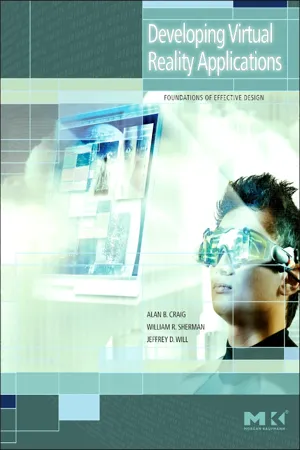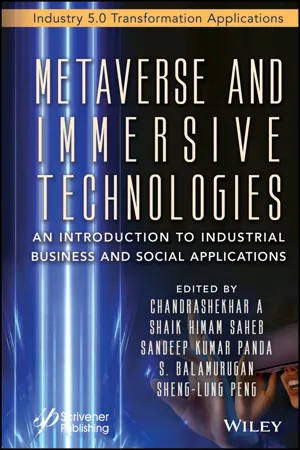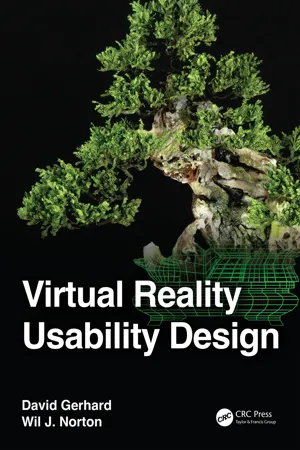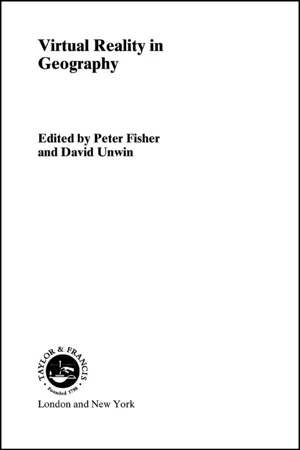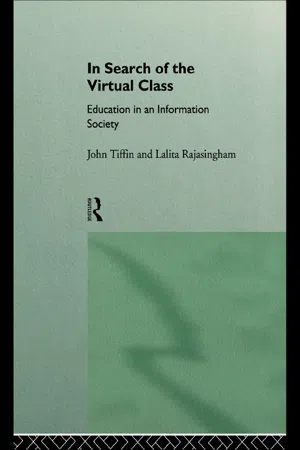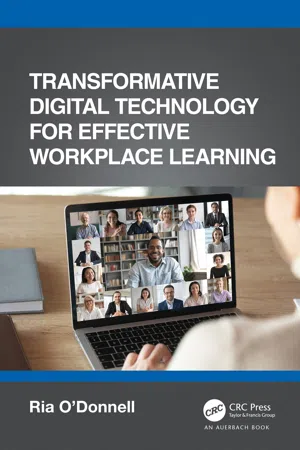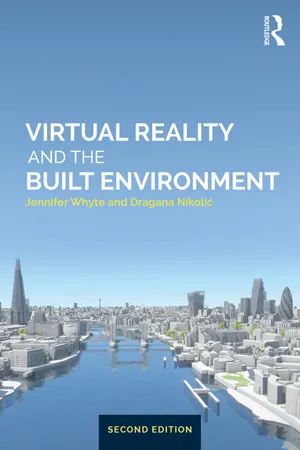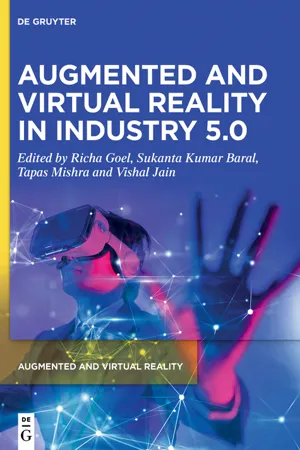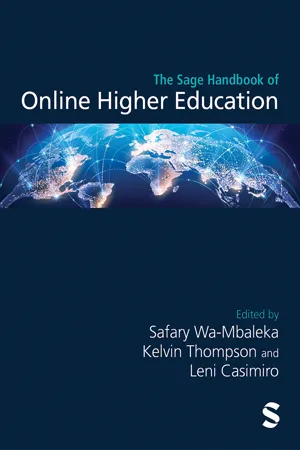Technology & Engineering
Virtual Reality
Virtual Reality (VR) refers to a computer-generated simulation of an environment that can be interacted with in a seemingly real or physical way. It typically involves the use of a headset and other sensory feedback devices to create an immersive experience for the user. VR technology has applications in various fields, including gaming, education, training, and healthcare.
Written by Perlego with AI-assistance
Related key terms
Related key terms
1 of 4
Related key terms
1 of 3
11 Key excerpts on "Virtual Reality"
- eBook - ePub
Developing Virtual Reality Applications
Foundations of Effective Design
- Alan B. Craig, William R. Sherman, Jeffrey D. Will(Authors)
- 2009(Publication Date)
- Morgan Kaufmann(Publisher)
Chapter 1. Introduction to Virtual Reality1.1. What is Virtual Reality?
When we speak of “Virtual Reality” (VR) we refer to a computer simulation that creates an image of a world that appears to our senses in much the same way we perceive the real world, or “physical” reality. In order to convince the brain that the synthetic world is authentic, the computer simulation monitors the movements of the participant and adjusts the sensory display or displays in a manner that gives the feeling of being immersed or being present in the simulation. Concisely, Virtual Reality is a means of letting participants physically engage in some simulated environment that is distinct from their physical reality.Virtual Reality is a medium, a means by which humans can share ideas and experiences. We use the word experience to convey an entire Virtual Reality participation session. The part of the experience that is “the world” witnessed by the participant and with which they interact is referred to as the virtual world. However, the term “virtual world” does not only refer specifically to Virtual Reality worlds. It can also be used to refer to the content of other media, such as novels, movies, and other communication conventions.Here is a more formal definition for Virtual Reality from Sherman and Craig:A medium composed of interactive computer simulations that sense the participant’s position and actions, providing synthetic feedback to one or more senses, giving the feeling of being immersed or being present in the simulation.Note that the definition states that a Virtual Reality experience provides synthetic stimuli to one or more of the user’s senses. A typical VR system will substitute at least the visual stimuli, with aural stimuli also frequently provided. A third, less common sense that is included is skin-sensation and force feedback, which is jointly referred to as the haptic (touch) sense. Less frequently used senses include vestibular (balance), olfaction (smell), and gustation - eBook - ePub
Metaverse and Immersive Technologies
An Introduction to Industrial, Business and Social Applications
- Chandrashekhar A, Shaik Himam Saheb, Sandeep Kumar Panda, S. Balamurugan, Sheng-Lung Peng(Authors)
- 2023(Publication Date)
- Wiley-Scrivener(Publisher)
13 Real-Time Applications of Virtual Reality R. Pranith, Kavali Maruthi and Shaik Himam Saheb*Faculty of Science and Technology, The ICFAI Foundation for Higher Education, Hyderabad, IndiaAbstract
Virtual Reality (VR) is a powerful invention and interactive technology that significantly impacts our lives. VR, often known as immersive multimedia, replicates a physical presence for the audience in both the real and virtual worlds. It often incorporates two senses: sight and sound. VR aims to make history by allowing employees to interact with virtual objects, collaborate, and meet up without ever leaving the office. This project report provides an overview of the present state of environment-related VR, focusing on live VR experiences. VR technology, art, and business are all quickly developing. The various domains of VR are discussed in order to understand it better. This report provides brief information about VR technology in the present situation, including various types of VR; uses in different sectors; VR in business, entertainment, and games; and other interesting elements of VR.Keywords: Virtual Reality, multimedia, virtual objects, interactive technology, VR experiences, virtual worlds13.1 Introduction
The term “virtual” is one of the most often-used words. Virtual schools, workplaces, pets, exhibitions, wind tunnels, performers, and studios are all accessible. Virtual museums and doctors are now possible thanks to Virtual Reality (VR). VR makes it possible for all of this. It offers the experience of things that are not constructed or not yet available in real life, like seeing the environment in another dimension. The world of 3-D graphics has no limits or restrictions and can be customizable by the user. A 4-D, i.e., the dimension of the user’s imagination, can be added to this world. They want to interact with and experience this world, not just watch it on a monitor. Virtual Reality - eBook - ePub
- David Gerhard, Wil J. Norton(Authors)
- 2022(Publication Date)
- CRC Press(Publisher)
I ________ Understanding Virtual Reality and UsersPassage contains an image
Chapter 1What Makes Virtual Reality Remarkable?DOI: 10.1201/9781003261230-11.1 DEFINING Virtual Reality
Virtual Reality (VR) is a medium that seeks to replicate the many sensations we humans experience when we interact with the physical world. Because it seeks to replicate reality, VR is defined by its resemblance to the physical world—while other computer interfaces may use audio output and visual display to represent digital information to the user, VR uses these technologies to “trick” the user into feeling as if the digital world is somehow real. The “virtual” part of Virtual Reality refers to that the world displayed on a VR device is of our own creation, as opposed to the physical world. However, by this logic, any fictional world is virtual, be it expressed through literature, visual arts, television, or video games. For a display to be considered Virtual Reality, the world displayed must be interactive, convincing, and similar to the physical world in terms of form, not just content.There's a wide diversity of definitions for the term Virtual Reality, but most people have an intuitive sense of what counts as Virtual Reality and what does not. Different Virtual Reality systems support the simulation of different senses at different levels of accuracy, and the applications (or experiences) supported across these systems vary widely in the accuracy of their own simulation. Regardless, these systems are still all considered to belong to the category of VR—therefore any definition of the term must be abstract enough to allow for this variety.Any definition for Virtual Reality requires us to first take a step back and define reality - eBook - ePub
- Peter Fisher, David Unwin(Authors)
- 2001(Publication Date)
- CRC Press(Publisher)
Part IIntroduction to VR and technology
Passage contains an image
2 Geography in VRContext
Ken Brodlie, Jason Dykes, Mark Gillings, Mordechay E. Haklay, Rob Kitchin and Menno-Jan Kraak
VR in geography
Given its ubiquity, researchers could be forgiven for believing that a concise and coherent definition of Virtual Reality (VR) exists, bolstered by a carefully-charted developmental history, a comprehensive list of the ways in which VR can be most profitably applied, and, perhaps most fundamentally of all, an encompassing critique of the technology.As noted in our editors’ Introduction (Chapter 1 ), reading the chapters in this book will show quite clearly that such a consensus doesn’t exist even in the restricted field of academic geography. The diversity of technologies and approaches employed by the authors of this first section demonstrates this point clearly. It would appear that there are as many ‘virtual realities’ as there are researchers actively involved with VR. This has not prevented these authors from offering definitions or frameworks derived from a bewilderingly wide range of fields (including computational mathematics, education, cartography and aesthetics), based on technologies, or by using purely pragmatic approaches. The latter are the most commonly encountered and are founded upon the assertion that if you are engaged with a representation to the point where your body is responding involuntarily to it as though it were the real world, then you are probably dealing with VR! In such a scheme the definition of VR is reduced to the creation of representations that are so convincing that were a virtual glass to fall from a virtual hand, the user would involuntarily reach out to catch it (Brodlie and El-Khalili, Chapter 4 ).Defining VR
Without wanting to anticipate these more detailed discussions, by way of introduction to this section we offer a very broad definition of the technology that emphasises the common elements in our work. We agree that VR is a form of human–computer interface (HCI). More specifically, in each case the process of using VR, or producing a VR simulation, involves the creation of a construct on the basis of a source reality, in our case the geographical environment (Figure 2.1a). This simple model can be expanded to include two other critical factors common to each of our applications. These are the geographical information derived from the environment and the users themselves (Figure 2.1b). To readers who have a background in cartography, it will be apparent that if we replace the terms ‘representation’ and ‘user’ with ‘map’ and ‘map image’ respectively, our framework for VR corresponds to the traditional cartographic process viewed as a series of transformations (Robinson et al. - eBook - ePub
In Search of the Virtual Class
Education in an Information Society
- Lalita Rajasingham, John Tiffin(Authors)
- 2002(Publication Date)
- Routledge(Publisher)
Virtual Reality will be linked to broadcast and wired telecommunications technology. These technologies are undergoing major changes that will mature in the next century. The ‘superhighways of information’ are being built. They will soon be in use and will dramatically enhance the possibilities of telecommunications. At the moment they are seen as providing video on demand and access to new information services. In the future they will link people together in virtual realities.Yet another technology in its infancy which will be related to Virtual Reality as it develops is nanotechnology. According to Eric Drexler (1990), this is not simply a trend towards miniaturisation of machines. A genuine technological revolution is involved when it becomes possible to build and control machines and computers at the molecular level.1 This is when a total, realistic, Virtual Reality environment for all the senses becomes feasible.Virtual Reality is not something new. We have been seeking it down the ages. Looking back at the path we have taken in the search gives an idea of where we may be going. What we will call ‘computer-generated Virtual Reality’ (CGVR) is a new way of doing something that people have been doing for a long time. Experiencing a reality which seems real, but is not, is as old as dreaming, and humans have been using technology to induce it ever since they began to paint on cave walls2 and use mind-altering drugs.Language can evoke in the mind scenes that are not present in reality, as can the light waves emitted from a television screen or the dancing flames of a fire. What makes the new VR technology different is that the virtual realities are computer-generated, as distinct from the text-generated, film-generated or chemically generated virtual realities we are accustomed to. The question is whether CGVR can provide a better alternative for instruction to the old VR technology of the books and pictures used in conventional classrooms. - Ria O'Donnell(Author)
- 2021(Publication Date)
- Auerbach Publications(Publisher)
Chapter 7 Immersive Technologies for Workplace LearningDOI: 10.1201/9781003149132-8As technological trends point firmly toward the use of advanced simulations, immersive technologies are making a mark on the educational landscape. Because of their ability to bring the user into a sensory environment, the impact on learning is usually significant in terms of engagement, context, and motivation. While there is a considerable way to go in terms of widespread adoption, affordability, and seamless technological experiences, the use of immersive technologies in the workplace is growing slowly but steadily, with the potential for expansion on the horizon. This chapter outlines some of the benefits for workplace learning, the implementation of immersive technologies, measuring the impact on learning and development, meaningful assessment, and some of the common challenges involved with including immersive technologies in workplace learning.The term immersive technology is used to describe devices and applications that simulate a virtual world, or characteristics of such, in which a user can feel immersed in their environment. The inclusion of sensory stimulation enhances the ‘real’ feeling, allowing the user to participate in ways beyond what they do in their regular, physical world.This chapter will examine how Virtual Reality (VR) and augmented reality (AR) can be used to enhance workplace learning. The first thing to clarify is that VR and AR are not interchangeable terms. VR is a three-dimensional, fully simulated environment that emulates real-world experiences or acts as an imaginary world. These virtual environments usually use a VR headset to project the experience and stimulate a variety of senses, predominantly visual, but also auditory, olfactory, haptic, and taste (Chandrasekera & Yoon, 2018 ). In comparison, AR is an overlay of virtual elements onto the user’s real physical environment. It is considered a hybrid of physical and virtual realities (Chandrasekera & Yoon, 2018). Scavarelli (2020) describes the differences between VR and AR as follows: “VR is an artificial environment in which a computer provides sensory stimuli that can be manipulated by one’s actions. AR uses virtual objects that are superimposed into the real world, supplementing reality rather than replacing it.” So, while there can be similarities and overlaps between VR and AR, they are two distinctly different technologies (Figure 7.1- eBook - ePub
4D CAD and Visualization in Construction
Developments and Applications
- Raymond Issa, I. Flood, W. O'Brien(Authors)
- 2003(Publication Date)
- CRC Press(Publisher)
The flexibility offered by virtual environments to visualize and interact with the virtual world, provided that these technologies are available at a reasonable cost, will enable designers, clients, and contractors to use VR to rapidly construct and test their prototypes before constructing the actual project. But this only happens if the strengths of the technology are emphasized and the hype is significantly played down. VR should be treated not as a technology in its own right, but in terms of a suite of technologies, which when carefully implemented, are capable of matching the capabilities of humans to the requirements of the application or task he or she is required to work with.The potential of VR can only be realized if it is integrated with construction applications packages. An ICE should be developed where all construction applications are integrated through a central intelligent core. VR can play a major role in the development of a human computer interface for such an environment. Whether immersive or non-immersive techniques are used, users can visualize design and construction information in 3D, photo-realistic, and interactive images. Moreover, VR displays and interactive devices should only be selected on the basis of (a) human factors issues, i.e. what is expected of the performance and well-being of the ultimate human user, and (b) customer requirements.ROBOTICS INTEGRATION IN THE CONSTRUCTION WORKFORCE THROUGH VR
Mobility on the job site
Robots in construction are part of a system made up, as shown in Figure 4, of four basic, interacting components: operator, computer, robot, and the construction environment. The design of new robots to supplement the construction workforce can only be achieved with the help of VR. VR can be of valuable assistance in both geometric aspects, such as link dimensions, work envelope and dexterity, as well as in control aspects, such as, visualizing sensor data and virtual navigation controllers. By combining and integrating reflex control and virtual environments, great progress can be made toward completely autonomous robots.Figure 4. Robotic system model.Reflex control allows us to establish a direct link between information and action, thus bypassing the high resource overhead requirements associated with the decision making stage. This inclusion of decision in information is only possible in well-identified environments (Burdea & Coiffet, 1994). - eBook - ePub
- Jennifer Whyte, Dragana Nikolić(Authors)
- 2018(Publication Date)
- Routledge(Publisher)
In contrast with the 2D and 3D representations discussed previously, some distinguishing characteristics of VR environments make them more interactive, spatial and social. In addition, the degree of interaction virtual environments afford also distinguishes them from animations and 3D movies. In VR, users are not constrained to predetermined viewpoints and can choose how to navigate and what to see within an environment. Furthermore, in a VR environment, users not only typically have navigation capabilities, but they may also have the ability to use devices or gestures to change the parameters of the environment or create objects within it.As with the actual world, people tend to be able to intuitively interact with virtual environments, and often understand the effects of their actions. However, interaction with a virtual environment is usually not the same as interaction with a physical environment. For example, our perceptions of time and distance in a VR model often differ from our real-world experiences, as navigating a virtual environment is not typically bound to transportation modes we experience moving through the real world. Put another way, a realistic walking speed may seem slow in VR, and unlike in the real world, users may be able to fly, jump and speed through the environment. Moving between two points in a virtual model is often much faster than would be possible in the real world.To date, basic applications that allow interaction with simple VR models are available on mobile computing devices, and even greater realism and interaction are possible for users with access to higher-end VR facilities. However, navigating a virtual environment can often be problematic and limited, as body movements in VR environments tend to be constrained and distorted. In some immersive VR applications, the user experience is generally disembodied, as our bodies do not move within a model, but rather the virtual world moves in relation to us. This disembodied experience is even more prominent when using head-mounted displays, for which a user’s body is typically not represented in a virtual space. - eBook - ePub
Clinical Psychology
A Global Perspective
- Stefan G. Hofmann(Author)
- 2017(Publication Date)
- Wiley-Blackwell(Publisher)
21 Virtual RealityCristina Botella, Rosa M. Baños, Azucena García‐Palacios, and Soledad QueroA world without rules or controls, borders or boundaries. A world where anything is possible. Where we go from there is a choice I leave to you . . .What is real? How do you define real? If you are talking about what you can feel, what you can smell, what you can taste and see, then real is simply electrical signals interpreted by your brain . . .Have you ever had a dream Neo, that you were so sure was real? What if you were unable to wake from that dream? How would you know the difference between the dream world, and the real world?Neo and Morpheus dialogue, The MatrixIntroduction
Although Ivan Sutherland is usually recognized as the first author to write in the 1960s about an illusion generated by a computer, Jaron Lanier coined the term “Virtual Reality” (VR) in 1989 and popularized its modern usage. One of the most attractive possibilities of VR is that it can replay sensorial information from the physical world, creating an indistinguishable, or almost indistinguishable, analogue of the real world. Through this technology, it is possible to generate artificial experiences in environments created graphically in three dimensions and let the user interact with these simulated environments as if they were the real world.From a psychological perspective, VR is mainly a mental experience that makes the user believe that he / she is there and that this experience is real. When using VR, the person is no longer a mere observer of what is happening on a screen. He / she is an active participant who can feel immersed in this VR world, even though it only exists in the computer's memory and the user's mind. This feeling of being there, of judging the experience as somewhat real, being surrounded by a reality whose perceptive clues are recognized by the users, impacting them emotionally, and making them feel present in a world that responds to their actions, has been called sense of presence - eBook - ePub
- Richa Goel, Sukanta Kumar Baral, Tapas Mishra, Vishal Jain(Authors)
- 2023(Publication Date)
- De Gruyter(Publisher)
VR and AR are two of the most viable solutions for creating learning objects and meeting their basic needs. Technological integrations in the learning area will improve deeper awareness through a multisensory atmosphere [ 1 ]. 1.1 Virtual Reality interactions VR allows users to engage with computer-based surroundings, enhanced by a graphic system and a wide range of display and input devices. Virtual Reality technology primarily provides prospective education, including the competence to permit beginners to visualize and interrelate with 3D virtual representations, real-time immersion in the virtual environment, visualize the effective relationship among some attributes in a virtual environment system and intellectual concepts, assimilate their understanding of phenomena by composing or controlling virtual surroundings, and permit individuals to co-operate with one another in social settings. With such capabilities, in which some are unique to this sector, VR has several educational aids that, if properly applied, will exert a strong influence on its application to education. For example, in the field of specialized vocational training, the usage of VR headsets may significantly improve vocational training. Figure 10.1: Images on Virtual Reality. Participants can utilize Virtual Reality technology to involve themselves in virtualized scenarios, based on the frequent issues faced in any particular industry/business. One of the most attractive aspects of VR as a learning aid is its capacity to present items and situations that are not ordinarily accessible to humans, but allow people to interact with them, for instance, by reaching out to ‘touch’ the atoms of a complicated molecule which is shown in Figure 10.1. It can also simply transform a wheelchair into a vehicle capable of transporting its owner across the world, for example, virtual safari parks or cities - eBook - ePub
- Safary Wa-Mbaleka, Kelvin Thompson, Leni Casimiro, Safary Wa-Mbaleka, Kelvin Thompson, Leni Casimiro(Authors)
- 2023(Publication Date)
- SAGE Publications Ltd(Publisher)
Ongoing research and improvements in the design of VR technology aim to address these negative experiences. Leigh (2019) examined styles of movement that can be used for traveling within VR, finding that some types of movements had more of an impact on visual fatigue and motion sickness. Such studies can assist VR application developers in determining the advantages and challenges of each method of travel for users.Design and Pedagogy
Although VR provides an environment with limitless potential for instruction and learning, it is only a tool. Excellent teaching and purposeful learning tasks are still needed. Therefore, there is a need for a clear and collective pedagogical framework to guide the design and implementation of VR systems in online education (Fowler, 2015; Mikropoulos & Natsis, 2011). In their review of studies on using VR in education, Mikropoulos and Natsis (2011) found that only a few studies have a clear theoretical (pedagogical) model informing the design and use of VR in a learning environment. Such a framework can help programs and instructors determine their instructional and VR environment design needs and the pedagogical methods they will use within the VR environment. Programs and instructors considering VR should consider the pedagogical implications of providing instruction in a virtual environment, such as what needs to be in the environment and how and when the instruction and students will access the environment.Determining the Level of Immersion Required for Learning
Determining the level of immersion needed for a given activity can also be challenging. Instructors will need to consider the nature and type of VR experience desired, while understanding that immersive VR systems require more advanced configurations to provide the user with a sense of immersion and presence (Bharathi & Tucker, 2015). Immersive VR systems differ significantly from non-immersive systems in generating higher levels of immersion and presence and producing greater learner engagement, satisfaction, and learning gains (Kozhevnikov et al., 2013; Mahmoud et al., 2020; Ventura et al., 2019). See Table 38.1
Index pages curate the most relevant extracts from our library of academic textbooks. They’ve been created using an in-house natural language model (NLM), each adding context and meaning to key research topics.
Explore more topic indexes
Explore more topic indexes
1 of 6
Explore more topic indexes
1 of 4
